In the ever-evolving world of electronics, Surface Mount Technology SMT components have emerged as a driving force behind the miniaturization, efficiency, and performance of electronic devices. As traditional through-hole components gradually make way for SMT counterparts, it becomes imperative to understand the significance and benefits of these tiny but mighty components. In this article, we delve into the world of SMT components, exploring their advantages, types, assembly process, industry applications, and prospects. Join us on this enlightening journey as we uncover the secrets behind the remarkable success of SMT technology.
What are SMT components on PCB?
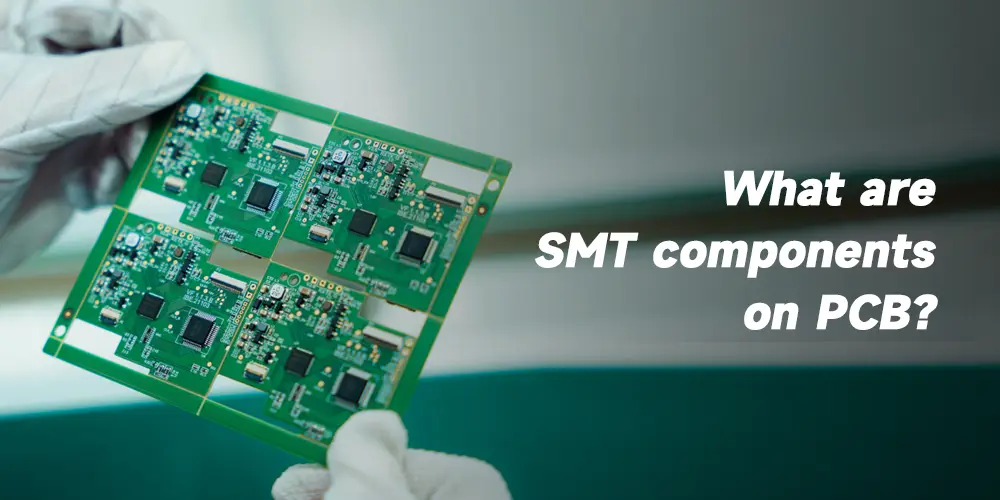
SMT components, short for Surface Mount Technology components, play a pivotal role in the construction of modern printed circuit boards (PCBs). Unlike their predecessors, through-hole components, SMT components are mounted directly onto the surface of the PCB, allowing for greater design flexibility, improved electrical performance, and efficient manufacturing processes.
These miniature electronic components are designed to be placed and soldered onto specific pads or lands on the surface of the PCB, eliminating the need for drilled holes and lead that pass through the board. This groundbreaking shift in component mounting has revolutionized the electronics industry by enabling the creation of smaller, lighter, and more sophisticated devices.
The primary advantage of SMT components lies in their size and package design. They are manufactured in a range of tiny form factors, such as resistors, capacitors, diodes, transistors, and integrated circuits (ICs), allowing for higher component density on the PCB. This increased density not only saves valuable board space but also enhances signal integrity and electrical performance.
Furthermore, SMT components offer improved high-frequency characteristics and reduced parasitic effects compared to through-hole components. With shorter electrical paths and reduced lead lengths, SMT technology minimizes signal loss, impedance mismatch, and electromagnetic interference (EMI), ensuring superior performance in today’s high-speed electronic applications.
By leveraging automated assembly processes, SMT components enable faster and more cost-effective PCB manufacturing. Solder paste is applied to the PCB pads through a stencil, and the components are then precisely placed onto the paste using pick-and-place machines. The entire assembly is subjected to reflow soldering, where the solder paste is melted, forming reliable and robust electrical connections.
The proliferation of SMT components across various industries, ranging from consumer electronics to automotive and medical devices, showcases their versatility and widespread adoption. As technology continues to advance, the demand for smaller and more powerful electronic devices grows, making SMT components an indispensable part of modern PCB design.
In the next sections, we will explore the uses of SMT components, delve into the different types available, discuss the SMT assembly process, highlight their industry applications, and peek into the future trends that hold promising developments for SMT technology.
What are SMT components used for?
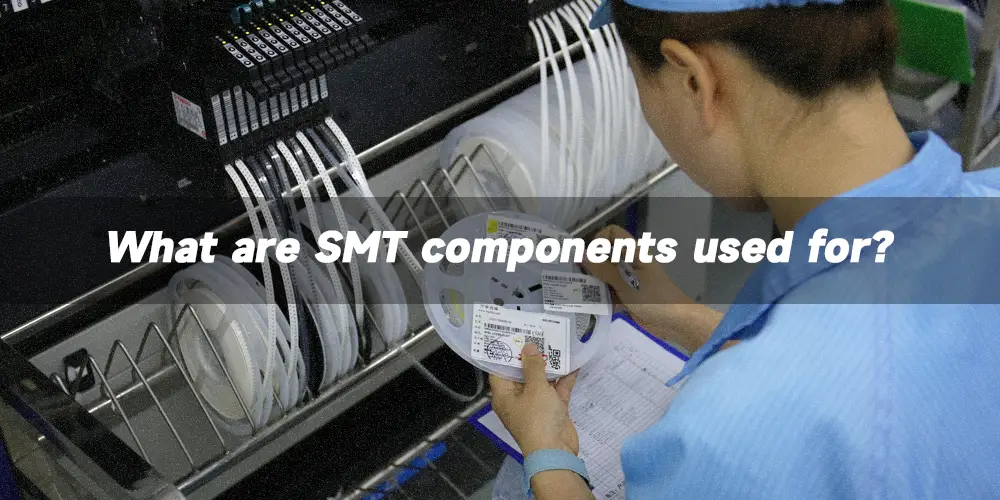
SMT components find wide-ranging applications across various industries, owing to their compact size, improved performance, and efficient manufacturing processes. Let’s explore some of the key industries where SMT components are extensively utilized:
● Consumer Electronics: From smartphones and tablets to televisions and gaming consoles, SMT components are the backbone of modern consumer electronic devices. Their small footprint allows for sleek and compact designs while delivering high functionality. SMT components enable the production of lightweight and portable gadgets that have become an integral part of our daily lives.
tive: The automotive industry heavily relies on SMT components for electronic systems, including engine control units, infotainment systems, advanced driver-assistance systems (ADAS), and lighting modules. SMT technology enables the integration of complex electronics into vehicles, improving performance, reliability, and space utilization.
● Telecommunications: In the realm of telecommunications, SMT components play a vital role in the development of communication devices and networking equipment. They are used in mobile phones, routers, switches, base stations, and satellite communication systems. SMT components enable the efficient transmission of signals, ensuring reliable and high-speed connectivity.
● Medical Devices: Medical devices demand high precision and reliability, making SMT components an ideal choice for their manufacturing. From implantable devices like pacemakers and hearing aids to diagnostic equipment and monitoring systems, SMT components provide compactness, durability, and superior performance, contributing to advancements in healthcare technology.
● Industrial Automation: SMT components are extensively utilized in industrial automation systems, including robotics, control panels, sensors, and motor drives. Their small size, high-speed capabilities, and resistance to harsh environments make them suitable for industrial applications where efficiency, accuracy, and durability are crucial.
● Aerospace and Defense: The aerospace and defense sectors rely on SMT components for critical applications such as avionics, radar systems, navigation systems, and communication equipment. SMT technology enables the development of lightweight and reliable electronics that can withstand extreme conditions and stringent requirements.
● Renewable Energy: SMT components are employed in renewable energy systems like solar inverters, wind turbines, and energy storage systems. Their compactness and high efficiency contribute to the optimization of energy generation, conversion, and management, fostering sustainable power solutions.
These are just a few examples of the broad spectrum of industries where SMT components find application. As technology continues to advance, SMT components are expected to play an increasingly significant role in emerging fields like the Internet of Things (IoT), artificial intelligence, and smart devices, paving the way for a more connected and efficient future.
In the next section, we will explore the different types of SMT components, shedding light on their characteristics and functions.
How many types of SMT components are there?
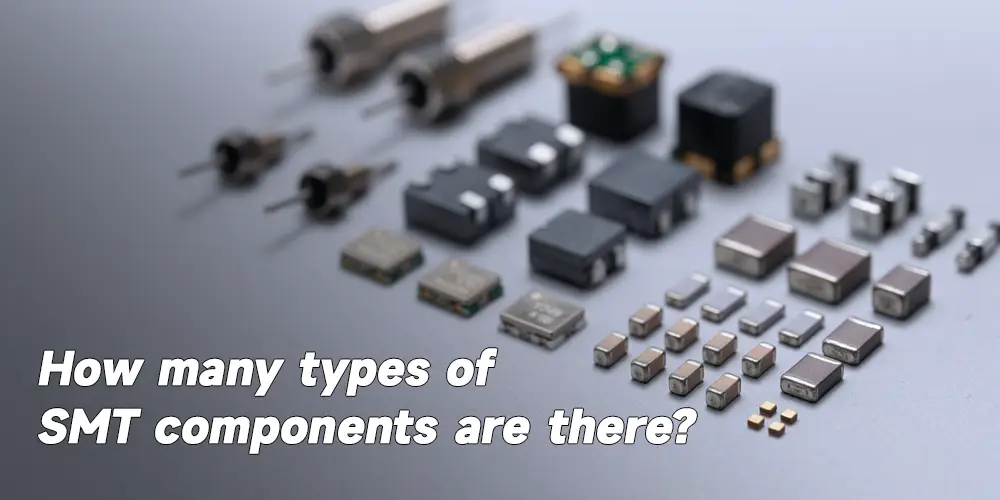
A wide variety of SMT components are available, each designed to fulfil specific functions in electronic circuits. Let’s explore some of the standard SMT components commonly used in PCB designs:
● Resistors: Resistors are passive electronic components that restrict the flow of electrical current in a circuit. SMT resistors come in various packages, such as chip resistors (rectangular-shaped) or resistor networks (multiple resistors in a single package). They provide precise resistance values to control current levels, voltage divisions, and signal attenuation in electronic circuits.
● Capacitors: Capacitors store and release electrical energy, playing a crucial role in filtering, decoupling, and energy storage applications. SMT capacitors are available in different types, including ceramic capacitors, tantalum capacitors, and electrolytic capacitors. They offer capacitance values, voltage ratings, and temperature characteristics suitable for diverse circuit requirements.
● Diodes: Diodes are semiconductor devices that allow current to flow in one direction while blocking it in the opposite direction. SMT diodes, such as surface mount rectifier diodes and Schottky diodes, are widely used for rectification, signal clamping, and voltage regulation in electronic circuits.
● Transistors: Transistors are active semiconductor devices that amplify or switch electronic signals. SMT transistors, including bipolar junction transistors (BJTs) and field-effect transistors (FETs), are essential components in amplifiers, oscillators, voltage regulators, and digital logic circuits. They provide precise control over current flow and voltage amplification.
● Integrated Circuits (ICs): Integrated Circuits, also known as ICs or chips, are complete electronic circuits fabricated onto a single semiconductor substrate. SMT ICs encompass a vast range of functionalities, including microprocessors, memory chips, analog-to-digital converters (ADCs), digital-to-analog converters (DACs), and specialized application-specific integrated circuits (ASICs). They offer complex functionality in a compact package, enabling advanced electronic systems.
Apart from these standard SMT components, there are numerous others, such as inductors, connectors, crystals, switches, and more. Each component type serves a specific purpose in electronic circuitry, contributing to the overall functionality and performance of the device.
When selecting SMT components for a particular application, factors such as electrical specifications, size, temperature range, and reliability should be considered. It is essential to consult datasheets and component manufacturers for detailed information on specific components’ characteristics and recommended usage.
In the next section, we will explore the difference between SMT and SMD components.
What is the difference between SMT and SMD components?
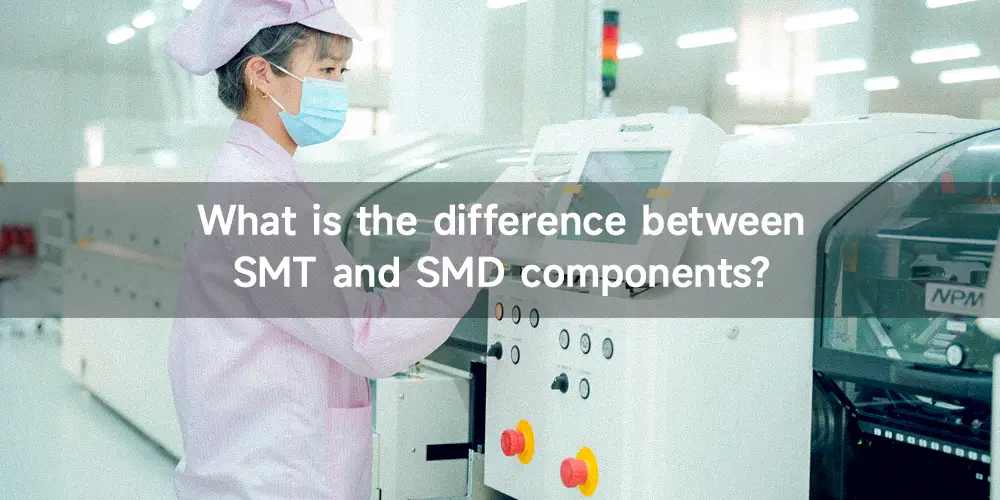
SMT (Surface Mount Technology) and SMD (Surface Mount Device) are terms often used interchangeably, but they refer to different aspects of surface mount electronic components. Let’s explore the difference between SMT and SMD:
SMT (Surface Mount Technology):
SMT refers to the overall technology and process of mounting electronic components onto the surface of a PCB. It involves the use of components that are designed specifically for surface mounting, as opposed to traditional through-hole components. SMT components have small footprints and are directly attached to the PCB’s surface using solder paste and reflow soldering techniques. The primary goal of SMT is to achieve higher component density, better electrical performance, and efficient manufacturing processes.
SMD (Surface Mount Device):
SMD refers to the individual electronic components themselves, specifically those that are designed for surface mounting. SMD components are characterized by their small size, compact packages, and the absence of leads or pins that pass through the PCB. Examples of SMD components include resistors, capacitors, diodes, transistors, and integrated circuits (ICs). These components are typically rectangular or square-shaped and have metalized terminals or contacts on the bottom surface, allowing for direct attachment to the PCB.
In summary, SMT refers to the overall technology and process of surface mount components, whereas SMD refers to the individual components designed for surface mounting.
It’s important to note that SMT components are often referred to as SMD components since they are the primary components used in the SMT process. Therefore, the terms SMT and SMD are often used interchangeably in everyday conversations.
What is SMT component placement?
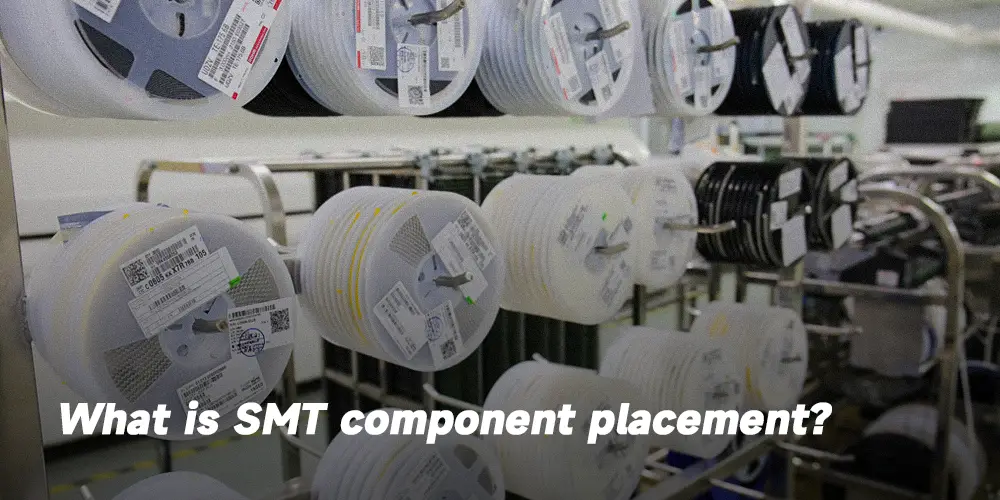
SMT component placement is a crucial step in the Surface Mount Technology (SMT) assembly process. It involves accurately positioning surface mount components onto the designated locations (pads) on a printed circuit board (PCB). This step requires precision and alignment to ensure proper electrical connections and overall functionality of the assembled PCB.
Here’s an overview of the SMT component placement process:
1.Pick-and-Place Machine: Component placement is typically performed using automated pick-and-place machines. These machines have specialized robotic arms equipped with vacuum nozzles or grippers that can handle and position SMT components accurately.
2.Component Data and Programming: Before placement, the pick-and-place machine needs component data and programming instructions. This data includes information about the component type, package size, orientation, and the specific location on the PCB where it should be placed. This information is usually provided through machine-readable files, such as a Bill of Materials (BOM) and Gerber files.
3.Feeder Setup: The pick-and-place machine is equipped with feeders that hold reels or trays containing SMT components. Each feeder is dedicated to a specific component type or package size. The operator sets up the feeders according to the BOM and component data, ensuring the correct components are available for placement.
4.Vision System Alignment: Modern pick-and-place machines often incorporate vision systems for precise alignment. The vision system uses cameras and image processing algorithms to locate fiducial marks or other alignment features on the PCB. This information helps the machine align the component placement accurately, compensating for any slight variations in PCB positioning or alignment.
5.Placement Process: During the placement process, the pick-and-place machine retrieves components from the appropriate feeders based on the programmed instructions. The machine’s robotic arm positions the vacuum nozzle or gripper over the component, picks it up, and then moves to the designated location on the PCB. The vision system aligns the component with the pads on the PCB, and the machine gently places the component onto the solder paste-covered pads.
6.Repeat and Inspection: The pick-and-place machine repeats this process for all the required components, following the programmed sequence. After the placement is complete, the assembled PCB undergoes inspection to ensure proper component alignment, orientation, and solder joint quality.
Accurate and precise placement is critical to achieving reliable electrical connections, avoiding short circuits, and maintaining signal integrity. Advanced pick-and-place machines can achieve high-speed and high-accuracy component placement, contributing to efficient and reliable SMT assembly processes.
What is the smallest SMT component size?
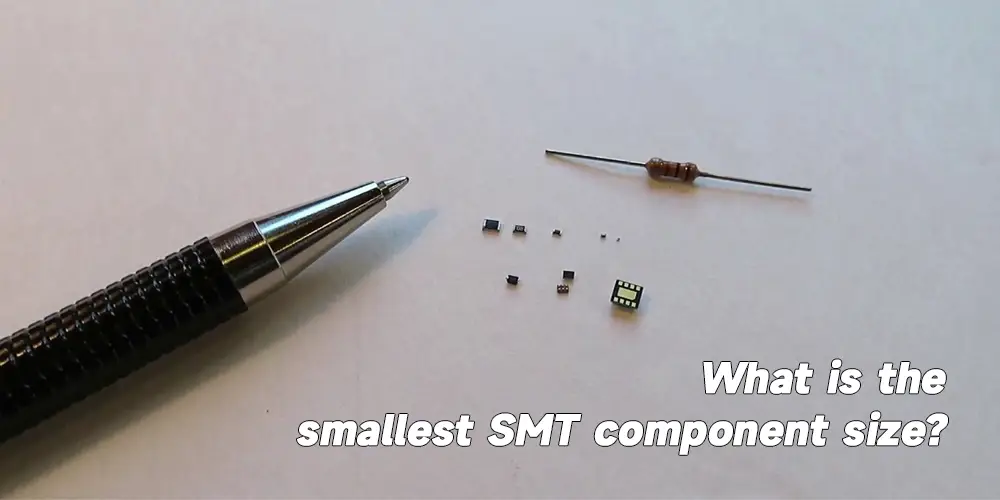
The smallest SMT component sizes can vary depending on technological advancements and specific component types. Over the years, manufacturers have developed increasingly miniaturized SMT components to meet the demands of compact electronic devices. Here are some examples of small SMT component sizes:
0201 Package Size:
The 0201 package size is among the smallest commonly used SMT components. The numerical designation represents the component dimensions in imperial units, where “02” indicates a length of 0.02 inches and “01” indicates a width of 0.01 inches. These components are typically used for passive components like resistors and capacitors.
01005 Package Size:
The 01005 package size is even smaller than 0201. Again, the numerical designation refers to the component dimensions, with a length of 0.01 inches and a width of 0.005 inches. These tiny components are challenging to handle and assemble due to their size, requiring advanced manufacturing techniques and specialized equipment.
Wafer-Level Chip Scale Packages (WLCSP):
WLCSPs are a type of SMT component that is directly mounted onto the PCB without the use of an intermediate package. These components are extremely small and often feature a size measured in micrometers (µm). They are commonly used for integrated circuits (ICs) and provide compact solutions for high-density circuitry.
It’s worth noting that the smallest SMT component sizes may vary between different manufacturers, and specialized applications may require even smaller or customized components. As technology advances, there is a constant drive to develop smaller and more efficient SMT components to meet the demands of miniaturized electronics.
Keep in mind that handling and assembling these miniature components require specialized equipment, skilled operators, and controlled manufacturing processes to ensure precise placement and reliable soldering.
What is the shelf life of SMT components?
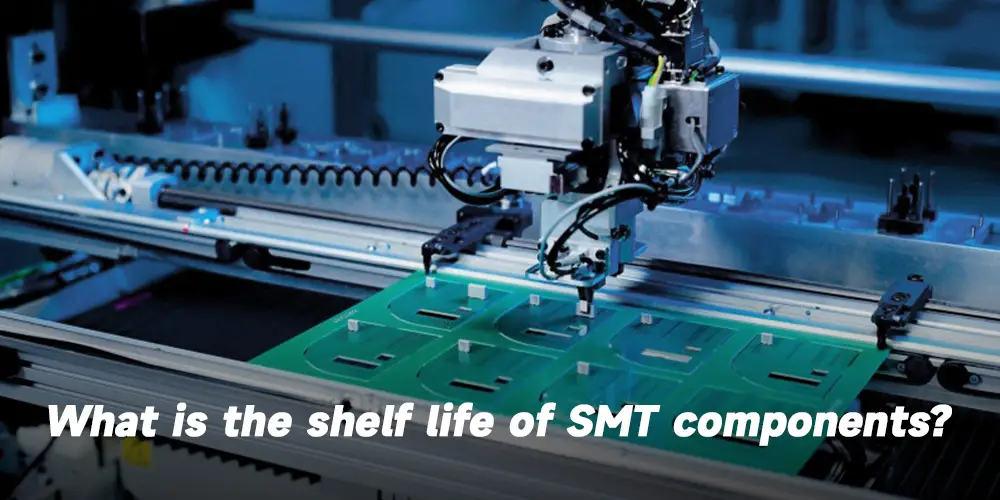
The shelf life of SMT (Surface Mount Technology) components refers to the duration during which the components can be stored and still maintain their optimal performance and reliability. It is influenced by various factors, including the component type, packaging, storage conditions, and the manufacturer’s recommendations. Here are some general guidelines regarding the shelf life of SMT components:
● Moisture Sensitivity: Many SMT components, such as integrated circuits (ICs), have moisture sensitivity ratings. They are typically marked with a Moisture Sensitivity Level (MSL) designation, ranging from MSL 1 to MSL 6. The MSL rating indicates how sensitive the component is to moisture absorption and the precautions needed during storage and assembly. Components with higher MSL ratings typically have shorter shelf lives and require special handling and packaging to prevent moisture-related damage.
● Desiccant Packaging: To mitigate the effects of moisture, SMT components are often shipped and stored in moisture barrier bags with desiccant packets. These bags provide a controlled environment, protecting the components from humidity and moisture absorption. It is important to keep the components sealed in their original packaging until they are ready for use.
● Component Type: Different SMT components may have varying shelf lives based on their construction, materials, and sensitivity to environmental factors. Manufacturers often provide recommended shelf life information for their specific component types. It is advisable to consult the component datasheets or contact the manufacturer for precise details regarding shelf life.
● Storage Conditions: Proper storage conditions play a significant role in extending the shelf life of SMT components. Components should be stored in a controlled environment with stable temperature and humidity levels. Generally, a cool, dry, and static-free storage area is recommended. Extreme temperatures, high humidity, exposure to direct sunlight, and electrostatic discharge (ESD) can negatively impact component performance and lifespan.
● Manufacturer Recommendations: It is crucial to follow the manufacturer’s guidelines and recommendations for storage and handling. The manufacturer’s documentation, datasheets, or technical specifications often provide information on recommended storage conditions, shelf life, and precautions specific to their components.
It is important to note that the shelf life of SMT components may vary. Some components, especially those with moisture sensitivity, may have shorter shelf lives, while others can remain viable for longer periods if stored appropriately.
To ensure optimal performance and reliability, it is recommended to use components within their specified shelf life. If components have exceeded their recommended shelf life or have been exposed to adverse storage conditions, it is advisable to consult the manufacturer for guidance or consider replacing them. Remember to review the specific component datasheets and manufacturer guidelines for precise information regarding the shelf life of the components you are working with.
Conclusion
In conclusion, SMT components play a pivotal role in modern electronics manufacturing. They offer numerous advantages such as compactness, improved performance, and efficient assembly processes. With the ability to achieve higher component density and enhance electrical performance, SMT components have become the standard choice for a wide range of industries.
We explored the basics of SMT components, their purpose, types, and the difference between SMT and SMD. We also delved into the importance of accurate component placement and the challenges associated with handling smaller sizes. Additionally, we discussed the shelf life of SMT components and the significance of proper storage conditions.
Thank you for joining us on this journey into the world of SMT components. If you have any further questions or need more information, don’t hesitate to seek additional resources or reach out to experts in the field. Happy manufacturing and designing!
FAQ about SMT components
Yes, it is common to use a combination of SMT components and through-hole components on the same PCB. Through-hole components are typically used for larger components or components that require mechanical stability, while SMT components offer compactness and are suitable for high-density designs.
SMT components can offer excellent reliability when properly manufactured and assembled. They have advantages such as better thermal characteristics, improved high-frequency performance, and efficient automated assembly processes. However, the reliability of any component depends on factors like design, manufacturing quality, and operating conditions.
While it is possible to hand-solder SMT components, it can be challenging due to their small size and precise soldering requirements. Hand-soldering SMT components often requires specialized tools, techniques, and a high level of skill. Automated soldering methods, such as reflow soldering, are typically used for mass production.
Solder paste is a mixture of tiny solder particles and flux. It is applied to the PCB's pads before component placement. The solder paste is then heated during the reflow soldering process, melting and forming the solder joints that connect the SMT components to the PCB.
SMT components can be reworked or removed from a PCB using specialized rework equipment and techniques. This process typically involves heating the solder joints to melt the solder, allowing the component to be safely removed or replaced. Care must be taken to avoid damaging the PCB or nearby components during the rework process.
While SMT components offer numerous advantages, there are a few limitations to consider. Some limitations include higher sensitivity to moisture and temperature, challenges in rework and repair, and the need for specialized equipment for assembly. However, these limitations can be overcome with proper handling, storage, and manufacturing processes.










